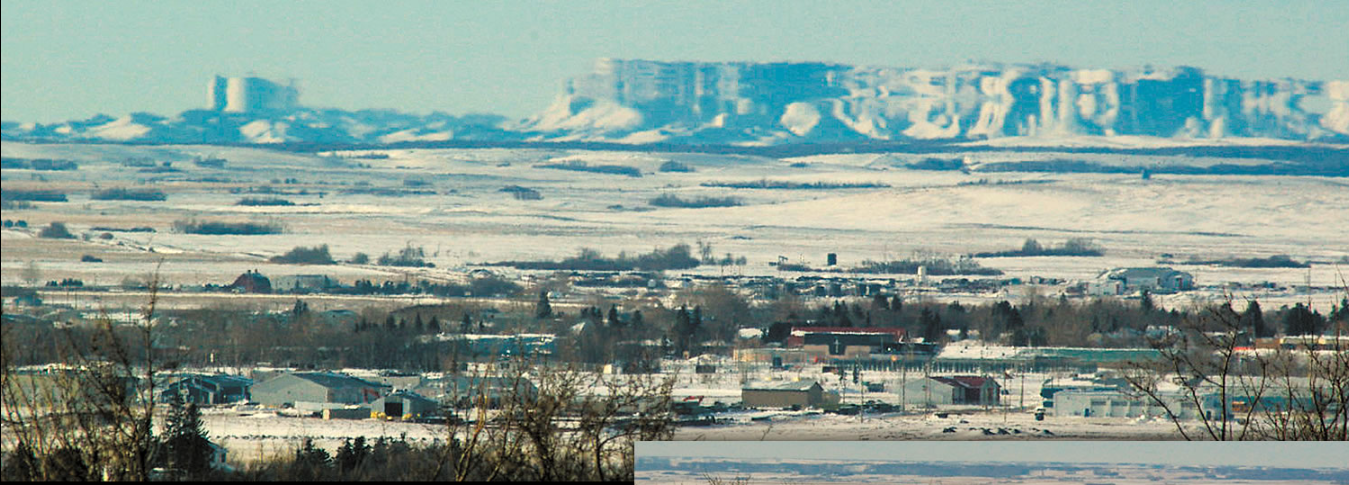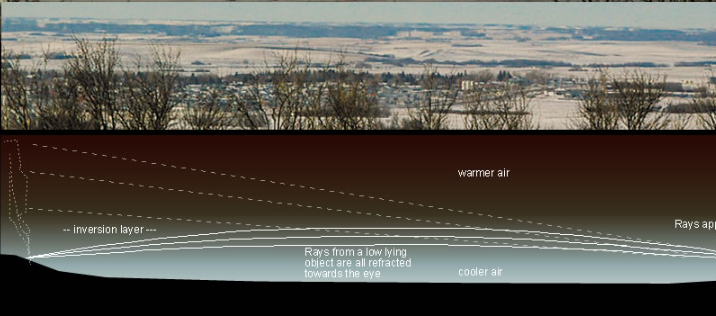Fata Morgana - Provost, Alberta
Fata Morgana: A Phenomenon of Illusory Beauty
Have you ever witnessed a mirage that seemed to defy reality? The enchanting atmospheric phenomenon known as Fata Morgana can create mesmerizing illusions, captivating the observer with its surreal and otherworldly appearance. One such occurrence took place in Provost, Alberta, captured by Richard Holmes, the editor of Provost News. Let us delve deeper into the fascinating world of Fata Morgana and explore the intricacies behind this captivating optical phenomenon.
Mirages come to life when light rays undergo refraction and curvature as they pass through air layers of varying density and temperature. The classic example of a mirage is the "hot road" or inferior mirage, where the miraged image appears inverted and below the "real" one. However, Fata Morgana takes the concept of mirages to extraordinary heights. This extreme and complex variant of a superior mirage manifests as fantastical towering cliffs, seemingly defying the laws of nature.
The name "Fata Morgana" originates from the mythical enchantress Morgana, who was King Arthur's half-sister. Legend has it that these mirages resemble views of her island palace, further enhancing the allure and mystique surrounding this phenomenon. To witness a Fata Morgana, specific atmospheric conditions must align. A crucial requirement is a temperature inversion, where warmer air rests above cooler air. In these instances, temperature gradients within the air layers increase significantly with height.
The intricate nature of Fata Morgana involves multiple curved light rays converging towards the observer's eye. This convergence creates an illusionary effect, making objects appear smeared upwards into towering cliffs. The phenomenon is not uniform but exhibits various inverted and stepped sections. The temperature inversions responsible for Fata Morgana are far from simple, often accompanied by atmospheric waves that cause different sections of the mirage to vary in height.
While Fata Morgana can potentially occur anywhere, it is most commonly observed during extremely cold weather or in Arctic regions, where frigid air blankets the ground. These conditions create the ideal environment for temperature inversions to take place, giving rise to the captivating illusions of Fata Morgana.
To summarize the key points about Fata Morgana:
- Fata Morgana is an atmospheric optical phenomenon that creates captivating illusions.
- Mirages occur when light rays refract and curve through air layers of varying density and temperature.
- Fata Morgana is an extreme and complex variant of a superior mirage.
- The name "Fata Morgana" is derived from the mythical enchantress Morgana.
- Specific atmospheric conditions, including temperature inversions, are necessary for Fata Morgana to occur.
- Temperature inversions involve warmer air resting above cooler air, with increasing temperature gradients at higher altitudes.
- Multiple curved light rays converge towards the observer's eye, creating the illusion of objects smeared into towering cliffs.
- Fata Morgana exhibits various inverted and stepped sections, with height variations caused by atmospheric waves.
- The phenomenon is most commonly observed during very cold weather or in Arctic regions.
- Fata Morgana adds an element of enchantment to the natural world, captivating all who witness its illusory beauty.
Next time you find yourself in a cold climate or Arctic region, keep an eye out for the ethereal beauty of Fata Morgana. This mesmerizing phenomenon serves as a reminder of the hidden wonders that lie within our atmosphere, waiting to be discovered and appreciated.

Fata Morgana at Provost, Alberta imaged by Richard Holmes editor of Provost News .
Image ©Richard holmes, shown with permission.

Mirages result when light rays are refracted and curved by passage between air layers of different density and temperature. The archetype is the 'hot road' or inferior mirage where the miraged view is inverted and beneath the "real" one. Here the mirage of the shallow distant hills (normal view at right) is above the real object and takes the form of fantastical towering cliffs. It is an extreme and complicated variant of a superior mirage and called a "Fata Morgana" after the fabled Morgana, enchantress half-sister of King Arthur. The mirages are perhaps views of her island palace. The Morgana needs a temperature inversion, warmer air above cooler, with temperature gradients in parts increasing strongly with height. Then, several rays from a relatively low lying object or even the ground are all curved towards the eye giving the impression that the object is smeared upwards into a cliff. In reality the Morgana is more complicated with parts inverted and stepped. The temperature inversions making them are not simple and may also have waves that cause different mirage sections to vary in height. Although the Morgana might be seen anywhere it mostly occurs during very cold weather or in Arctic regions where heavy frigid air overlays the ground.
Note: this article has been automatically converted from the old site and may not appear as intended. You can find the original article here.
Reference Atmospheric Optics
If you use any of the definitions, information, or data presented on Atmospheric Optics, please copy the link or reference below to properly credit us as the reference source. Thank you!
-
<a href="https://atoptics.co.uk/blog/fata-morgana-provost-alberta/">Fata Morgana - Provost, Alberta</a>
-
"Fata Morgana - Provost, Alberta". Atmospheric Optics. Accessed on April 19, 2024. https://atoptics.co.uk/blog/fata-morgana-provost-alberta/.
-
"Fata Morgana - Provost, Alberta". Atmospheric Optics, https://atoptics.co.uk/blog/fata-morgana-provost-alberta/. Accessed 19 April, 2024
-
Fata Morgana - Provost, Alberta. Atmospheric Optics. Retrieved from https://atoptics.co.uk/blog/fata-morgana-provost-alberta/.